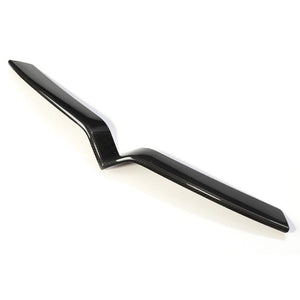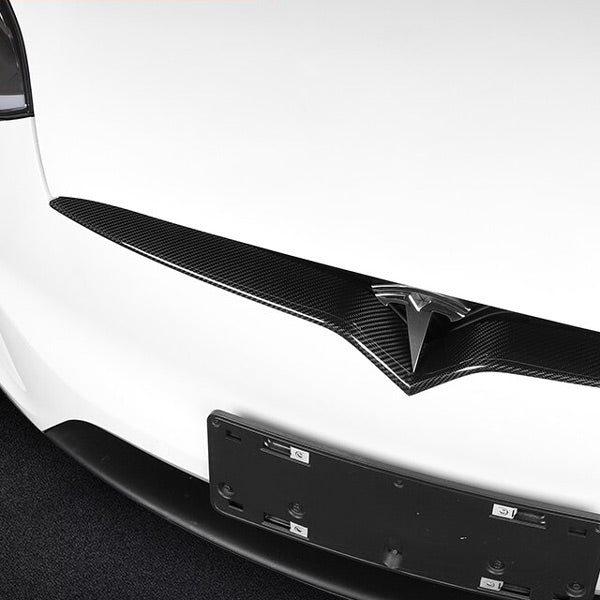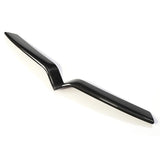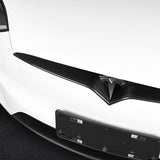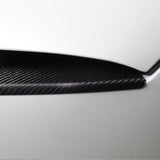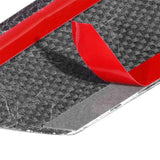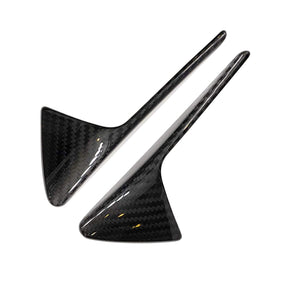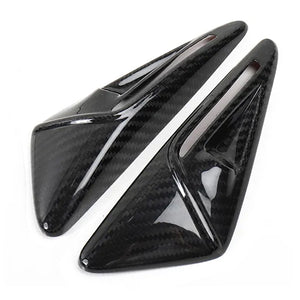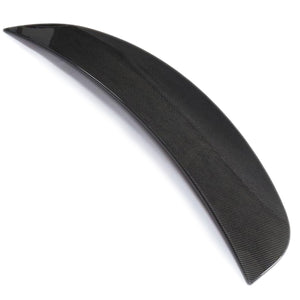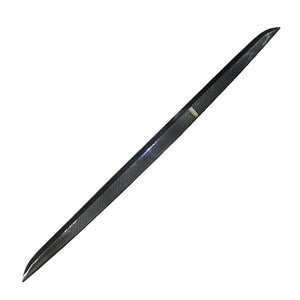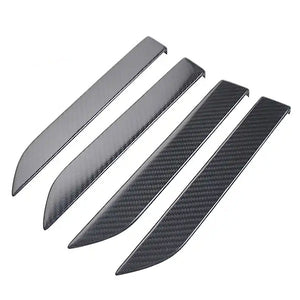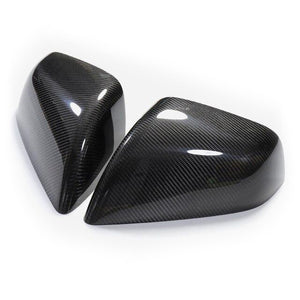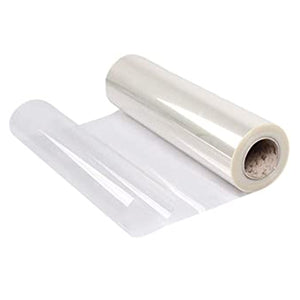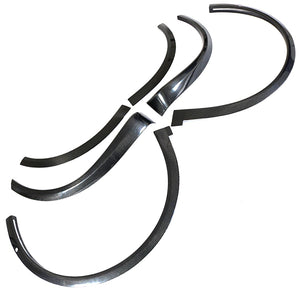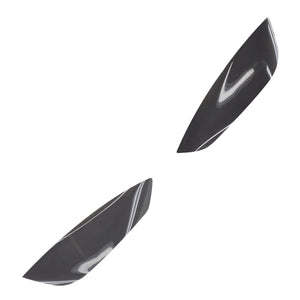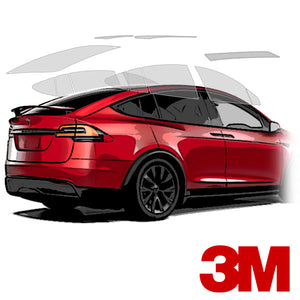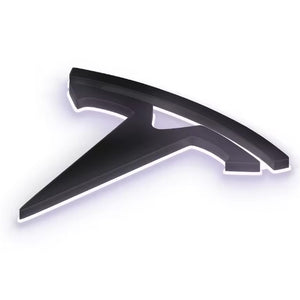Carbon Grille
Tesla Model X
This Carbon part will dominate the front of your Model X. Giving aggressiveness that is due to a Tesla, the sportiest SUV on the road!
An item made with Tesla Standard Carbon
The carbon weave used is the same as you can find inside the passenger compartment of your Tesla Model X in its performance version.
In gloss or matte finish, this real carbon grille insert will give an opposite contrast to the original chrome you have stock.
Features of the carbon grille insert for Tesla Model X
- Original design: changes the look of your Tesla
- Perfect finish: in real gloss carbon
- Applies easily: durable 3M double-sided
- Does not leave glue residue after uninstallation
-
2 year warranty
_________
Do you want to know the basics and results of Model Sport's carbon production process? What is a composite material? The usefulness of a carbon part in the different industries?
We are going to focus our description around three paragraphs:
• The real determination of a real carbon
• The different vision of the Model Sport brand in the realization of its carbon parts
• The products the most popular in the field
The product will have no more secrets for you as soon as you have explored this paragraph.
What is a composite material?
To put it simply, we only have to assimilate that what is called composite material suggests two materials that have synthesized with each other, without ever becoming homogeneous.
This combination will give you a single element which will have greater mechanical properties than if the components are used alone.
Carbon or Texalium, what can you find for your electric?
What we can say is that many carbon or Texalium parts exist and that many ways of presenting it in your vehicle are possible.
This is the true name "carbon fiber composite" that must be used, even if in the majority of cases, the latter is called "carbon". This denomination is more accurate.
200 gram 3K twill carbon fabric:
The 3K carbon twill, one of the most widespread in the automotive field and many other uses are devoted to it, let's see what is special about it. Each way of weaving carbon has a specific name, that of twill is one of them.
You can see what the twill describes in the image just above. There is a reason why twill is very noticeable: firstly its ability to adapt to molds with a strong curve, secondly its aesthetic appearance giving the impression of a diagonal weave.
There are even more accentuated details such as the 3/1, 2/2 and 4/4 criss-crossing, but this is not a technical development, but more of a brief explanation. The 3K sign means 3000 carbon strands for one weft. As a rough guide, a strand of carbon is only 1/20th the thickness of a hair.
So there are several designations, the most common are 1K, 3K, 6K, 12K. The Tesla community is particularly accustomed to observing 3K. Finally, to finish the description of the carbon fabric, if 200gr/m² is mentioned, this characterizes its weight on a surface of 1 meter x 1 meter before it is associated with resin.
For the Tesla community, the 3K twill in 200gr/m² is the most appreciated for its aesthetic appearance considered much better than its comrades, but in no way for its mechanical endurance provisions.
Let's talk about forged carbon:
A denomination that may seem abusive for an appearance that is very divergent from the standards, however, this molding technique is nothing new.
To give you a simplistic definition, so-called "forged carbon" refers to a unique production process: carbon fiber is cut into small pieces and then dispersed evenly in a mold. It is now necessary to put the resin and tighten the positive and negative master of the mold until putting them under pressure.
The mold temperature is also increased during this phase. The process used for the manufacture of forged carbon thus gives a big benefit on rigidity and lightness, because the density of carbon obtained per square centimeter compared to the resin is higher.
You have to go back to the 1980s to discover the first uses of forged carbon in the warhead development industry, however this development process was noticed only from its use in the brand Lamborghini.
The Texalium: an unknown figure that occupies an important place
Texalium is a completely different material, generally mistaken for carbon by amateurs.
It is in order to acquire the desired appearance that this material is actually fiberglass loaded with aluminum, the resin or the varnish will then be nuanced to give it a specific color.
Its mechanical provisions are below the usual glass fabric (itself below the carbon fabric) and its application is purely for aesthetics. Know that Texalium is a material that has existed for years, but is little used in France. It is also much more widespread and on the Atlantic side.
Carbon: what is it?
We are going to present you various pieces made from this famous fiber.
If you are interested in a product or part, Model Sport can provide you with a quote.
What mechanical stress can be exerted on carbon?
This question once and for all acquires an appropriate answer. It is very interesting to wonder if the famous carbon is more resistant than another material?
To give you an idea: an aluminum alloy that has a physical volume equal to a carbon part will be less resistant than the latter, all stresses combined. It is important to come back to the term “resistant”, because it means everything and nothing.
Because an aluminum part will perhaps behave better during impact, which will depend on the weaving used for the carbon in comparison. It is for this reason that for Tesla automobiles it is so common to manufacture ultra-thin carbon inserts that attach to existing parts without the inconvenience of breakage.
For the 3 or Y model, the dashboard cover insert is a very good example, but this part of more than 1 meter 40 can be produced in only two layers of carbon fabric, with a thickness not exceeding 0.5 mm shipped throughout France without suspicion of breakage.
How to explain the price of carbon?
To assimilate its final price, you must first assimilate its production: Let's already see how the development of a single carbon frame takes place.
To roughly define the stages of production of a single carbon fiber, you have to start your work with a synthetic fiber called polyacrylonitrile, this one will be put under oxidation, then logically carbonized to offer us this inimitable carbon fiber.
As you can imagine, the production of carbon fiber involves a number of chemicals that are certainly not good for the environment. It is for this reason that many institutions are creating projects to continue the production of carbon fiber in the future, while drastically reducing the use of non-natural products!
The use of bio-sourced materials is fashionable and even more and more essential to meet certain environmental criteria put in place. The goal: the elimination of chemicals, but also a division of the price. The carbon production operation also requires expensive and bulky specialized equipment, not to mention its weaving.
A carbon fiber is 20 times smaller than a human hair, that's what you have to remember.
30 euros per square meter is the average price, at the time of writing, that you can find a 200gr/m² 3K twill carbon sheet. Do not forget that we must add to this the cost of the resin, which we will see can have essentially variable prices depending on its quality, and also that very often, if not all the time, a carbon part is produced. in many layers. Then, the expertise of a laminator who knows how to install and put the materials in question in the right conditions.
The carbon of Model Sport and its unique layouts
A part that we have the chance to master, because we scrupulously analyze all the stages of production. It takes knowledge of the actual formatting of an element to be able to ensure an acceptable result.
It is for this argument that the creator of the Model Sport brand, designer and bodybuilder, makes every effort to deliver his know-how in the field of carbon components.
For Tesla, what to take between fabric or pieces of carbon?
It goes without saying that the carbon fabric is expressly used for its aesthetic appearance rather than its mechanical faculties.
To name just a few benefits of carbon: its resistance to torsion, bending and its lightness. However, these characteristics are often forgotten in the Tesla world. Automotive sportiness is the main purpose of these carbon elements.
It should be understood that even in the case of a body kit for Model S, 3, X or Y or any other automobile aimed at racing on the circuit, the opposites generated on the latter will be supported by the lowest carbon range ( so that there are some characterized as low-end).
You have to combine flexibility and versatility to find the most used type of carbon: HR, for "high resistance", is the reference in the field. The latter is the one used by the Model Sport company for the production of all its carbon elements. Very often, the HR is however combined with the HM, for "High Modulus", which will be much lighter, but much more brittle. It is for this argument that it is combined. The parallel we can draw is forged carbon, which has a higher mechanical function, but is used for its different aesthetics.
The important role that resin plays in assembly
Now let's talk about the key element of carbon parts: the resin.
For any piece that is intended for the general public and that requires mass production, polyester will be prioritized with the application of fiberglass. You should know that for carbon parts that will be very exposed to heat, polyester will also be used for its high resistance to high temperatures. It is this resin that is used for the production of exhaust cartridges for motorcycles, for example.
The primary benefit of epoxy resin is the resistance to stress it provides compared to polyester. Numerous tests have shown that one resin stands out among many others: anti-UV epoxy resin. It does not tarnish over time and maintains the true look of carbon. The aggressions of UV rays emitted by the sun will thus have no effect on your carbon parts, what is more, the appearance is more transparent.
This is a singularity that will only be felt several years after installation, but if the anti-UV treatment is not present, beware of yellowing of the parts.
As a result, three parameters enter into the calculation of the price of the resin: its application, its quality and its longevity.
Let's talk about the selling price of this famous resin in France:
• The kilo of Polyester resin is worth between 8 and 10€
• The kilo of Epoxy resin is worth between 50 and 60€
• The kilo of anti-UV Epoxy resin is worth between 55 to 65€
Paint finish for Tesla
This is of course the final phase of a customization project. To guarantee an almost infinite hold over time, at the very beginning we manufactured carbon components without any finishing paint.
The problem was that production was needed with no possibility of catching up and therefore a high rate of “waste”. The nerve center of Tesla is to promote the reduction of pollution, so the high scrap rate of this production method was ultimately a problem.
To obtain a more "standard" result in the production of our carbon components, we have therefore started to use a higher quality varnish. Once the glossy varnish has been applied, it will be carefully buffed to give it a polished surface. The mat, which does not benefit from any possible recovery thanks to polishing, is carried out by a professional painter in one go.
What kind of carbon fabric do we find on the Tesla Model S and X
Even though there are many customary points between the two models, there are still some notable differences depending on the production date.
It is for this reason that you will be asked for information about the year and month of production of your Tesla before shipment.
Tesla S or X interior trim
A real carbon tuning is also possible for Models S and X even if they are less numerous than the Model 3. The dashboard, the cup holder area or even the central console can receive a trim that differentiates it from the original.
The predominant point, the steering wheel, can also benefit from a fine-tuning with leather or Alcantara trim, depending on your choice. The latter will have a relatively precise customization, which many other accessories will be able to benefit from in the future.
Let's move on to the Model S and X bodywork
As for the Model S, the first element sought is the Performance-type Spoiler. In its matte version, you will have the same appearance as the one present on the Performance versions of the Model S, with the difference that the Model Sport has a different bonding surface and internal structure.
Once the spoiler is installed, no difference is visible. At this very moment, the latest version of the Plaid spoilers is also being designed to also receive mass production.
Carbon adapts to all supports. Although it is very often used in the particular field of the automobile simply for its appearance, it will find its place on components such as the grille or the mirror shells, with a slight loss of weight in the process. If you ever want a personalized creation based on Texalium or forged carbon, you can contact us by phone or email to find out more about your project on your Model S or X.
On the Tesla Model 3 or Y, what type of carbon construction?
The Tesla Model 3 is the electric sedan par excellence that marked its era, with an impressive number of carbon-based evolutions.
Tesla's two best-selling nuclear cars share a lot of similarities.
The Model 3 and Y and their cabin upgrades
Part of the Tesla community is undoubtedly familiar with carbon inserts for Model 3 or Y. The feat of the inserts and to succeed in developing in series an element that must scrupulously respect a given thickness in order to avoid the "addition" effect. This is where we find the surprising ability of inserts.
This is why it took us many attempts to finally succeed in producing extremely thin inserts to cover a dashboard, a door trim, a center console or even an armrest. while giving the impression of being part of the original finish.
The keys to a quality insert are tight cutting and precision gluing.
Replacement components such as the carbon dashboard combined with the door trim will give your vehicle a real finish in the chosen material.
The carbon dashboard and door trim are works of art that will give a totally different perception to the interior of your Tesla.
Model 3 and Y bodywork
The Model Y or 3 bodywork is not to be outdone with a good number of possible carbon-based customizations. A good way to transform the external visual aspect, with a composition in 3K twill or forged, and matte or glossy finish.
The Performance spoiler is a must in the series of carbon parts for Model 3. The same goes for the Model Y. To stick directly on the trunk (or trunk for the Model Y), it has become a standard of Tesla differentiation.
A more radical customization could be the change of the front bonnet to a carbon version. Two benefits: weight loss and an out-of-the-ordinary style.
- 🇫🇷 Gestionnaire Français
- Commandez directement au Fabricant ou au Distributeur
- Payez que votre produit (pas de frais de stockage ni de taxe territoriale)
- Livraison dans toute l'Europe !
Vous remarquerez que le bouton au-dessus vous redirige vers un des distributeurs ou fabricants du produit.
La major partie des accessoires Tesla proviennent de Chine, commander via les plateformes Aliexpress, Alibaba, Amazon, Hansshow ou Jowua vous donnera la possibilité d'obtenir le produit sans intermédiaire.
Les produits vendus en France ou en Europe proviennent du même fabricant Chinois (ou autre), mais avec une marge supplémentaire servant à payer les frais de fonctionnement de la société.
Cependant, l'avantage de commander à proximité est d'obtenir un délai de livraison plus rapide (néanmoins nous proposons aussi des produits expédiés directement depuis des stock Français ou Européens)
Model Sport a initialement commencé en faisant du stock en France, nous connaissons donc quels sont les fabricants de confiance et leur méthode de travail. Si bien que nous les citons avec leurs accords : MAOFA, BFB carbon, Yute Technologie, DCR Tuning, LITA Accessories, Jogon, Ever carbon, Carbonss Tuning, Jowua.
Ces fabricants, parmi quelques autres, sont les plus actifs et sérieux dans leur qualité de fabrication. Nous vérifions que les produits proviennent systématiquement de notre liste de fabricant. Ainsi, que vous commandiez via un distributeur Aliexpress, Amazon ou autre, nous savons que le produit sera de bonne facture.
